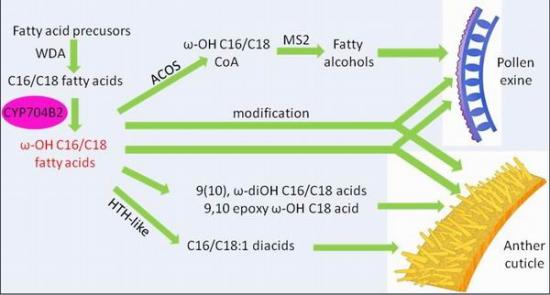花药发育和花粉形成是植物完成世代交替的重要环节,认识植物花药发育和花粉形成的分子机理,对于提高人们对植物基本生命现象的认识以及作物杂交育种提高农业产量具有重要意义。2010年虎年伊始,张大兵教授团队连续在植物科学领域顶级期刊《植物细胞》(The Plant Cell)发表了三篇研究论文,系统阐述了花药发育和花粉形成的关键基因及其网络调控机制,产生了较大的国际影响力。
通过遗传学、生物化学、细胞生物学等手段,张大兵教授团队揭示了控制水稻花药外表面结构(角质)和花粉外壁形成的关键基因CYP704B2;并提出植物花药表面角质层和花粉外壁的孢粉素成份的合成可能存在共同的生化途径(图1)。

图1 CYP704B2在花药角质和蜡质合成和发育中的作用
张大兵教授团队分离鉴定到一个控制水稻叶片中糖到花器官(包括花药)分配的关键转录因子CSA(Carbon Starved Anther),该转录因子可以直接控制花药中单糖转移酶的表达,从而实现对糖分子从源到库分配的调节(图2)。这项工作为进一步阐明糖分子在植物体内分配机制提供了重要依据,《植物细胞》编辑和审稿人对此工作给予高度评价。

图2 CSA参与水稻花粉发育过程中糖转动的调控模示图
2006年张大兵教授团队分离鉴定到一个控制水稻花药绒粘层细胞程序性死亡(programmed cell death)关键调节因子。
最近他们团队和英国诺丁汉大学Wilson博士实验室合作,通过基因芯片、染色质免疫沉淀、遗传分析等方法证明了AMS可以调节多个基因的表达,特别是寻找到了13个受AMS直接调控的基因,这些基因主要参与脂类的运输、脂肪酸的合成和代谢、甲基化的修饰以及果胶类的合成等重要的生物学过程。此外,还通过酵母双杂交等实验寻找到AMS在蛋白水平上与2个互作蛋白。该研究成果从基因组水平上揭示了AMS在花药和小孢子的发育过程的作用机制,为全面认识花粉发育的生物学过程奠定了基础。(生物谷Bioon.com)
生物谷推荐原文出处:
The Plant Cell>DOI:10.1105/tpc.109.070326
Cytochrome P450 Family Member CYP704B2 Catalyzes the> -Hydroxylation of Fatty Acids and Is Required for Anther Cutin Biosynthesis and Pollen Exine Formation in Rice[W],[OA]
Hui Lia, Franck Pinotb, Vincent Sauveplaneb, Danièle Werck-Reichhartb, Patrik Diehlc, Lukas Schreiberc, Rochus Frankec, Ping Zhanga, Liang Chena, Yawei Gaoa, Wanqi Lianga and Dabing Zhanga,d,1
a School of Life Science and Biotechnology, Shanghai Jiaotong University, Shanghai 200240, China
b Institut de Biologie Moléculaire des Plantes, Centre National de la Recherche Scientifique, Unité Propre de Recherche 2357-Université de Strasbourg, 67083 Strasbourg Cedex, France
c Institute of Cellular and Molecular Botany, University of Bonn, D-53115 Bonn, Germany
d Bio-X Research Center, Key Laboratory of Genetics and Development and Neuropsychiatric Diseases, Ministry of Education, Shanghai Jiaotong University, Shanghai 200240, China
The anther cuticle and microspore exine act as protective barriers for the male gametophyte and pollen grain, but relatively little is known about the mechanisms underlying the biosynthesis of the monomers of which they are composed. We report here the isolation and characterization of a rice (Oryza sativa) male sterile mutant, cyp704B2, which exhibits a swollen sporophytic tapetal layer, aborted pollen grains without detectable exine, and undeveloped anther cuticle. In addition, chemical composition analysis indicated that cutin monomers were hardly detectable in the cyp704B2 anthers. These defects are caused by a mutation in a cytochrome P450 family gene, CYP704B2. The CYP704B2 transcript is specifically detected in the tapetum and the microspore from stage 8 of anther development to stage 10. Heterologous expression of CYP704B2 in yeast demonstrated that CYP704B2 catalyzes the production of> -hydroxylated fatty acids with 16 and 18 carbon chains. Our results provide insights into the biosynthesis of the two biopolymers sporopollenin and cutin. Specifically, our study indicates that the> -hydroxylation pathway of fatty acids relying on this ancient CYP704B family, conserved from moss to angiosperms, is essential for the formation of both cuticle and exine during plant male reproductive and spore development.
The Plant Cell>doi:10.1105/tpc.109.073668
Carbon Starved Anther Encodes a MYB Domain Protein That Regulates Sugar Partitioning Required for Rice Pollen Development>
Hui Zhang 1, Wanqi Liang 2, Xijia Yang 2, Xue Luo 2, Ning Jiang 3, Hong Ma 4, and Dabing Zhang 1*
1 School of Life Science and Biotechnology, Shanghai Jiao Tong University, Shanghai 200240, China; Bio-X Research Center, Key Laboratory of Genetics and Development and Neuropsychiatric Diseases, Ministry of Education, Shanghai Jiao Tong University, Shanghai 200240, China
2 School of Life Science and Biotechnology, Shanghai Jiao Tong University, Shanghai 200240, China
3 Department of Horticulture, Michigan State University, East Lansing, Michigan 48824
4 State Key Laboratory of Genetic Engineering, Institute of Plant Biology, Center for Evolutionary Biology, School of Life Sciences, Fudan University, Shanghai 200433, China; Department of Biology, Huck Institutes of the Life Sciences, Pennsylvania State University, University Park, Pennsylvania 16082
In flowering plants, sink tissues rely on transport of carbohydrates from photosynthetic tissues (sources) for nutrition and energy. However, how sugar partitioning in plants is regulated at the molecular level during development remains unknown. We have isolated and characterized a rice (Oryza sativa) mutant, carbon starved anther (csa), that showed increased sugar contents in leaves and stems and reduced levels of sugars and starch in floral organs. In particular, the csa mutant had reduced levels of carbohydrates in later anthers and was male sterile. The csa mutant had reduced accumulation of 14C-labeled sugars in anther sink tissue. CSA was isolated by map-based cloning and was shown to encode an R2R3 MYB transcription factor that was expressed preferentially in the anther tapetal cells and in the sugar-transporting vascular tissues. In addition, the expression of MST8, encoding a monosaccharide transporter, was greatly reduced in csa anthers. Furthermore, CSA was found to be associated in vivo and in vitro with the promoter of MST8. Our findings suggest that CSA is a key transcriptional regulator for sugar partitioning in rice during male reproductive development. This study also establishes a molecular model system for further elucidation of the genetic control of carbon partitioning in plants.
The Plant Cell>doi:10.1105/tpc.109.071803
The ABORTED MICROSPORES Regulatory Network Is Required for Postmeiotic Male Reproductive Development in Arabidopsis thaliana[W],[OA]
Jie Xua, Caiyun Yangb, Zheng Yuana,b, Dasheng Zhanga, Martha Y. Gondweb, Zhiwen Dinga, Wanqi Lianga, Dabing Zhanga,c,1,2 and Zoe A. Wilsonb,2
a School of Life Science and Biotechnology, Shanghai Jiao Tong University, Shanghai 200240, China
b School of Biosciences, University of Nottingham, Sutton Bonington Campus, Loughborough, Leicestershire, LE12 5RD, United Kingdom
c Bio-X Research Center, Key Laboratory of Genetics and Development and Neuropsychiatric Diseases, Ministry of Education, Shanghai Jiao Tong University, Shanghai 200240, China
The Arabidopsis thaliana ABORTED MICROSPORES (AMS) gene encodes a basic helix-loop-helix (bHLH) transcription factor that is required for tapetal cell development and postmeiotic microspore formation. However, the regulatory role of AMS in anther and pollen development has not been fully defined. Here, we show by microarray analysis that the expression of 549 anther-expressed genes was altered in ams buds and that these genes are associated with tapetal function and pollen wall formation. We demonstrate that AMS has the ability to bind in vitro to DNA containing a 6-bp consensus motif, CANNTG. Moreover, 13 genes involved in transportation of lipids, oligopeptides, and ions, fatty acid synthesis and metabolism, flavonol accumulation, substrate oxidation, methyl-modification, and pectin dynamics were identified as direct targets of AMS by chromatin immunoprecipitation. The functional importance of the AMS regulatory pathway was further demonstrated by analysis of an insertional mutant of one of these downstream AMS targets, an ABC transporter, White-Brown Complex homolog, which fails to undergo pollen development and is male sterile. Yeast two-hybrid screens and pull-down assays revealed that AMS has the ability to interact with two bHLH proteins (AtbHLH089 and AtbHLH091) and the ATA20 protein. These results provide insight into the regulatory role of the AMS network during anther development.







